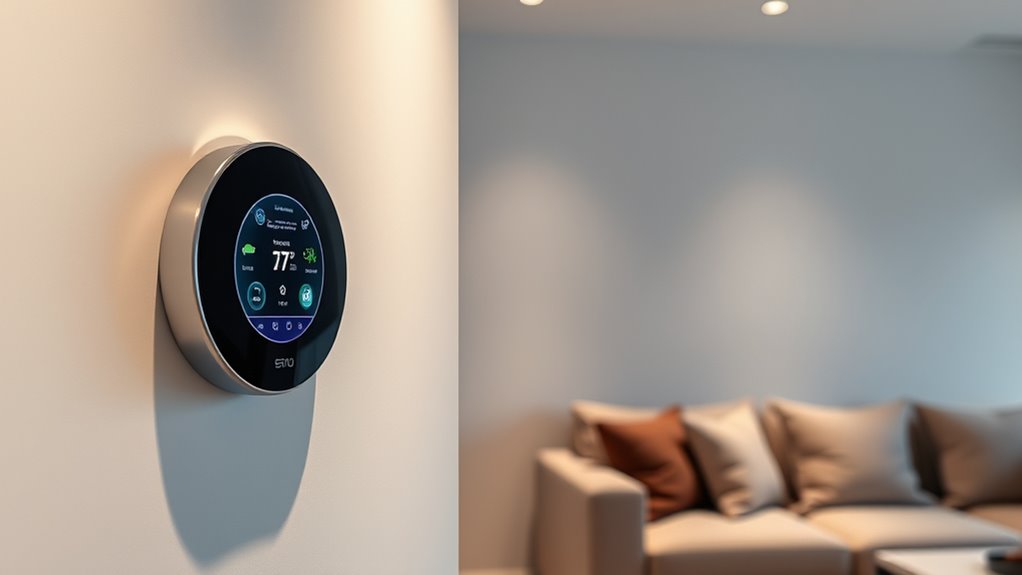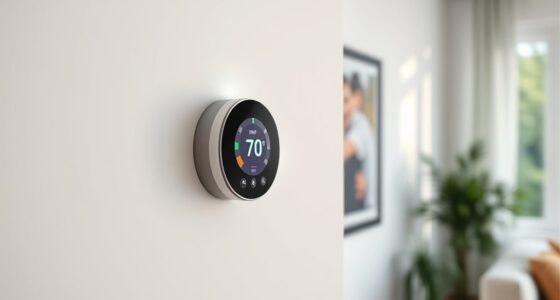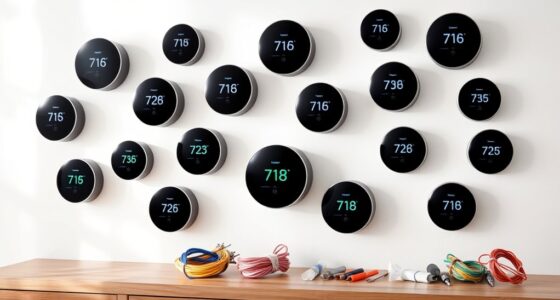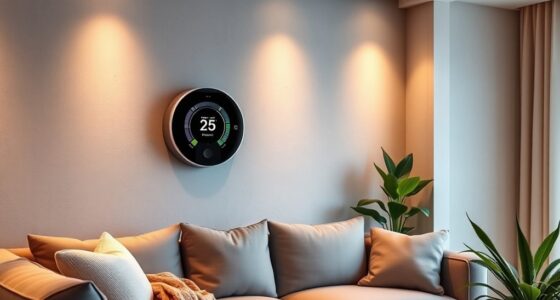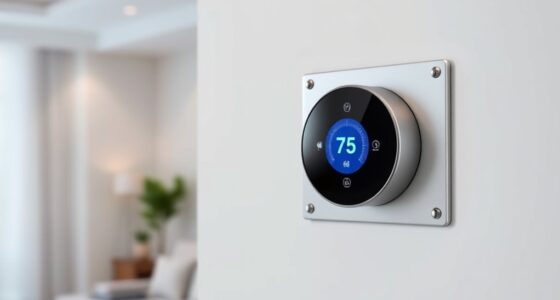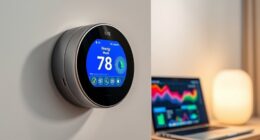If you’re looking for the best smart thermostats with climate prediction features, I recommend models like the Nest Learning Thermostat, ecobee Smart Thermostat Enhanced and Premium, Sensi Touch, and meross WiFi Thermostat. These devices learn your habits, adjust for weather changes, and optimize energy use for comfort and savings. They integrate smoothly with smart home systems like Alexa and Google Assistant. Keep going to discover more details on choosing the perfect one for your home.
Key Takeaways
- Many top smart thermostats utilize climate prediction algorithms to optimize comfort and energy efficiency automatically.
- Features like occupancy sensing and weather integration help anticipate temperature needs before adjustments are needed.
- Popular models such as ecobee and Nest leverage machine learning for accurate climate forecasting.
- Climate prediction capabilities enable preheating or pre-cooling, reducing waste and enhancing home comfort.
- Compatibility with various HVAC systems ensures these thermostats can deliver advanced climate management seamlessly.
Google Nest Learning Thermostat (4th Gen, 2024)

Are you looking for a smart thermostat that seamlessly adapts to your home’s heating and cooling needs? The Google Nest Learning Thermostat (4th Gen, 2024) is designed to do just that. It works with most 24V systems, often without needing a C wire, and integrates effortlessly with Matter-compatible devices. Its sleek design features a larger display and Dynamic Farsight, making information visible from across the room. You can control it via the Google Home app, voice commands, or directly on the device. Its self-learning capabilities optimize schedules over time, helping you save energy while maintaining your comfort effortlessly.
Best For: homeowners seeking an intelligent, adaptable thermostat that integrates seamlessly with various smart home systems and offers energy savings.
Pros:
- Self-learning technology that automatically optimizes heating and cooling schedules for energy efficiency and comfort.
- Large, attractive display with Dynamic Farsight for easy visibility from across the room.
- Compatible with most 24V systems and Matter-enabled devices, with no C wire often required for installation.
Cons:
- May require professional installation for complex HVAC systems.
- Higher initial cost compared to basic thermostats.
- Dependence on Wi-Fi and app connectivity for full functionality and remote control.
meross Smart Thermostat for Home, WiFi Thermostat
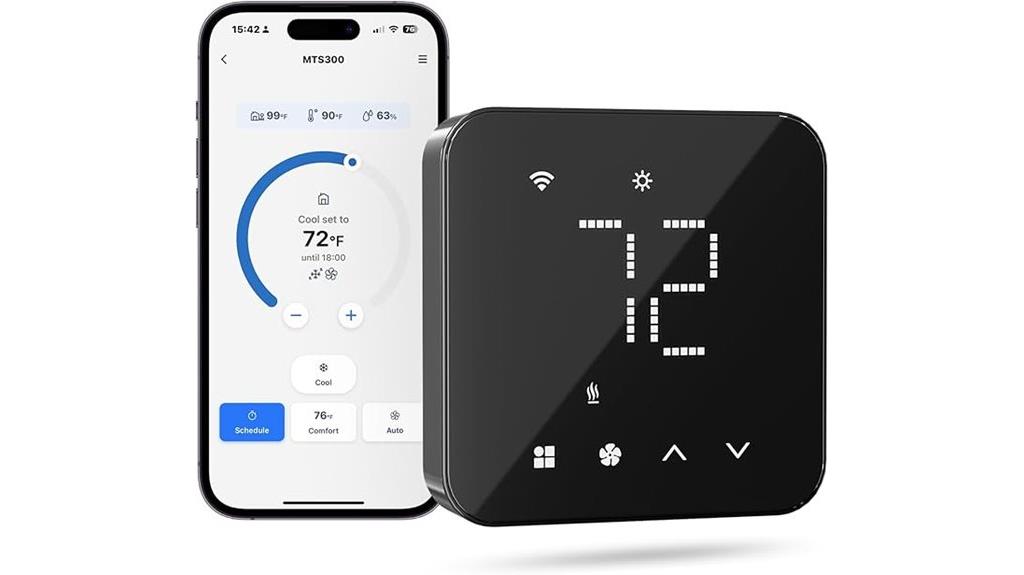
The meross Smart Thermostat is an excellent choice for homeowners seeking reliable, easy-to-install climate control that works with most HVAC systems. It supports 95% of systems, including conventional, heating-only, cooling-only, and heat pumps, though it’s not compatible with electric baseboard heaters. Installation is simple, often completed in 30 minutes with the Meross app. It helps save energy through customizable schedules that maintain home comfort even during Wi-Fi outages. You can control it remotely via the app and enjoy seamless voice integration with platforms like Alexa, Google Home, and Apple Home, thanks to Matter support. It also provides useful alerts for system health and maintenance.
Best For: homeowners seeking an easy-to-install, reliable Wi-Fi thermostat compatible with most HVAC systems including heat pumps and conventional setups.
Pros:
- Supports 95% of HVAC systems, including heating-only, cooling-only, and heat pumps
- Easy installation typically completed within 30 minutes using the Meross app
- Provides remote control and smart scheduling to optimize energy savings and maintain comfort
Cons:
- Not compatible with electric baseboard heaters
- Requires a C-wire for proper operation; must purchase an adapter if absent
- Only supports 2.4GHz Wi-Fi networks, limiting compatibility with some modern routers
Sensi Touch 2 Smart Thermostat with Touchscreen
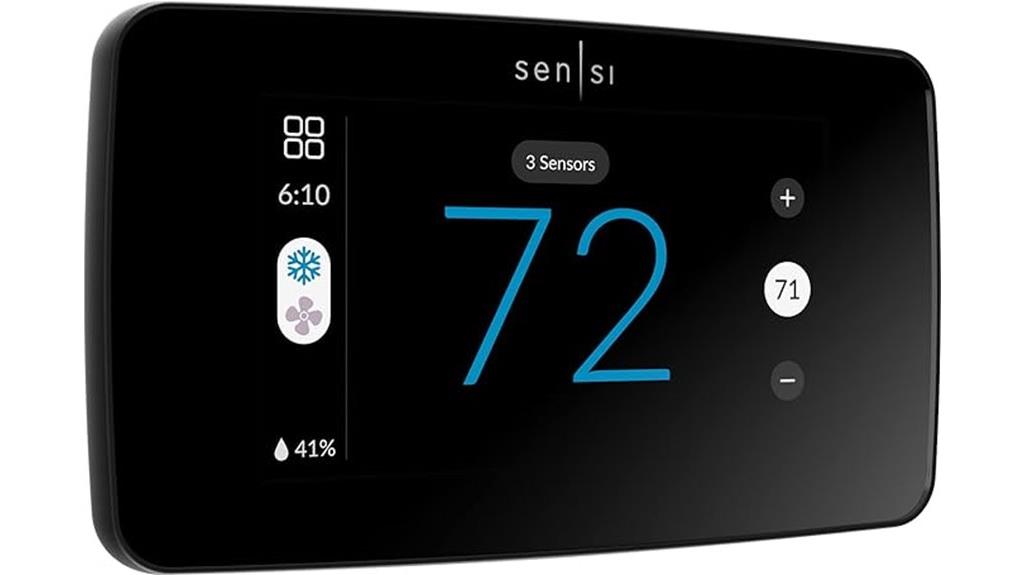
If you value a sleek, user-friendly interface and want precise control over your home’s temperature, the Sensi Touch 2 Smart Thermostat with Touchscreen is an excellent choice. It features a modern LCD touchscreen, programmable scheduling, and smart control via Alexa, Google Assistant, and Samsung SmartThings. Compatible with most HVAC systems, including boilers, heat pumps, and furnaces, it’s easy to install with the guiding app. It helps save around 23% on energy costs, monitors system performance, and alerts you to maintenance needs. With remote access, room sensors, and a focus on privacy, it delivers reliable, efficient, and customizable comfort for your home.
Best For: homeowners seeking a sleek, easy-to-use smart thermostat that offers precise temperature control and energy savings.
Pros:
- Modern LCD touchscreen with intuitive interface for easy operation
- Compatible with popular voice assistants like Alexa, Google Assistant, and Samsung SmartThings
- Helps reduce energy costs by approximately 23% with scheduling, remote access, and performance monitoring
Cons:
- Limited temperature adjustment range for auxiliary heat or very low-temperature settings
- Some users experience difficulty accessing outside temperature data on the device
- Variability in technical support response and occasional hardware or software issues related to low-temperature management
ecobee Smart Thermostat Enhanced – Programmable Wifi Thermostat

For homeowners seeking to maximize energy savings and comfort, the ecobee Smart Thermostat Enhanced stands out with its ability to automatically adjust temperatures based on occupancy and climate predictions. It can save up to 26% annually on heating and cooling costs by detecting when your home is unoccupied and adjusting accordingly. The thermostat preheats or precools your home before arrival for instant comfort and fine-tunes temperature based on humidity. With SmartSensor technology, it monitors room-specific temperatures to focus on key areas. Compatible with major voice assistants and easy to install, this Energy Star-certified device offers seamless control and efficient home climate management.
Best For: homeowners seeking to maximize energy savings, enhance comfort, and integrate a smart thermostat seamlessly into their existing home automation systems.
Pros:
- Saves up to 26% annually on heating and cooling costs through automatic adjustments and occupancy detection.
- Compatible with major voice assistants like Siri, Alexa, and Google Assistant for convenient control.
- Easy to install with a Power Extender Kit and suitable for a wide range of HVAC systems, including heat pumps and boilers.
Cons:
- May require professional installation if HVAC wiring is complex or if a C-wire is not available.
- The advanced features and app control may have a learning curve for some users.
- Limited to Wi-Fi connectivity, so internet downtime could impact remote control capabilities.
ecobee Smart Thermostat Premium with Sensors and Air Quality Monitor
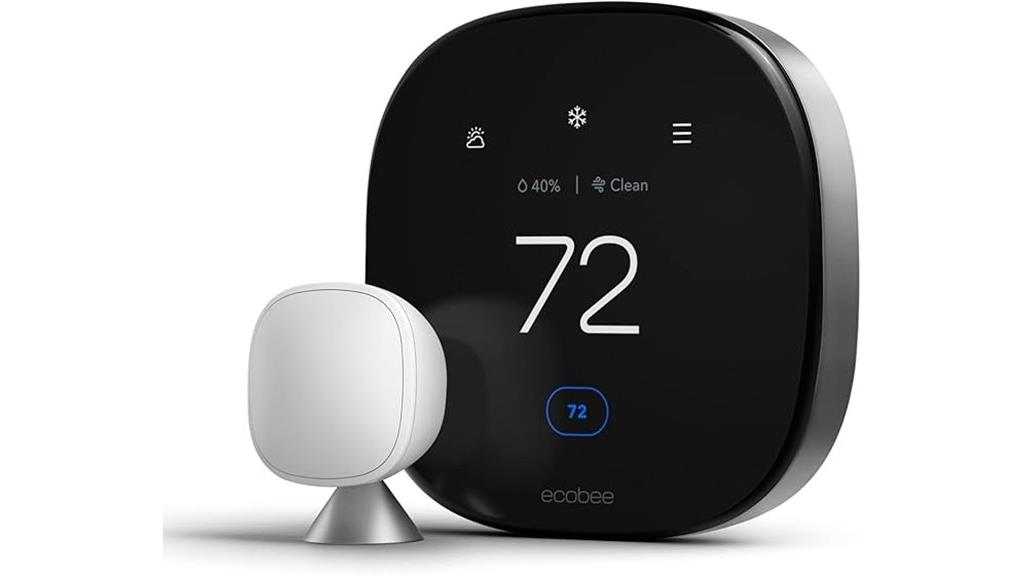
When aiming to cut heating and cooling costs while maintaining ideal air quality, the ecobee Smart Thermostat Premium with Sensors and Air Quality Monitor stands out as an excellent choice. It can save up to 26% annually on energy bills and is ENERGY STAR certified. The included SmartSensor adjusts temperatures in key rooms, reducing hot or cold spots. Its built-in air quality monitor alerts me to poor air conditions and suggests improvements, while also reminding me to change filters. The thermostat’s sleek design, vibrant display, and advanced occupancy sensing make it both functional and stylish. Plus, it integrates with voice assistants like Siri and Alexa, offering seamless control and enhanced home security features.
Best For: homeowners seeking to optimize energy savings, improve indoor air quality, and enjoy smart home integration with a sleek, user-friendly thermostat.
Pros:
- Saves up to 26% annually on heating and cooling costs, reducing energy bills.
- Built-in air quality monitor provides real-time alerts and maintenance reminders.
- Compatible with most 24VAC HVAC systems and voice assistants like Siri and Alexa for seamless control.
Cons:
- Requires a subscription to ecobee’s Smart Security plan for advanced security features.
- Apple Home Hub needed for Siri voice control integration.
- Might be more expensive than basic thermostats due to its advanced features and design.
ecobee Smart Thermostat Essential—Wi-Fi Programmable Thermostat
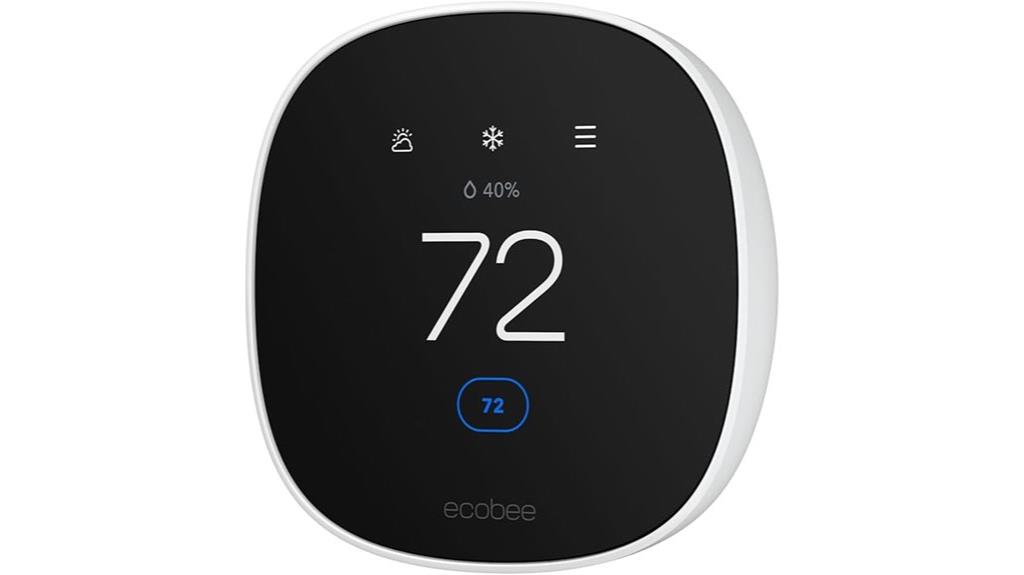
The ecobee Smart Thermostat Essential stands out as an excellent choice for homeowners seeking an affordable, energy-saving smart thermostat that integrates seamlessly with popular voice assistants and smart home platforms. It’s Energy Star certified, Wi-Fi enabled, and compatible with Siri, Alexa, Google Assistant, and Apple HomeKit. With an LCD display, touch controls, auto-scheduling, and fan control, it manages heating and cooling efficiently, especially for electric baseboard heaters and ACs. Installation is straightforward, and users report significant energy savings—up to 23%. Its sleek, white design and user-friendly app make it a practical, cost-effective upgrade for smarter home comfort and utility savings.
Best For: homeowners seeking an affordable, easy-to-install smart thermostat that offers energy savings and seamless integration with major voice assistants and smart home platforms.
Pros:
- Easy DIY installation with straightforward setup process
- Compatible with popular voice assistants like Alexa, Google Assistant, Siri, and Apple HomeKit
- Significant energy savings, potentially reducing utility bills by up to 23%
Cons:
- Limited scheduling flexibility, with only one schedule per season
- Cannot set different schedules for different seasons without manual re-entry
- Scheduling is restricted to 30-minute intervals, lacking minute-level customization
ecobee Smart Thermostat Enhanced
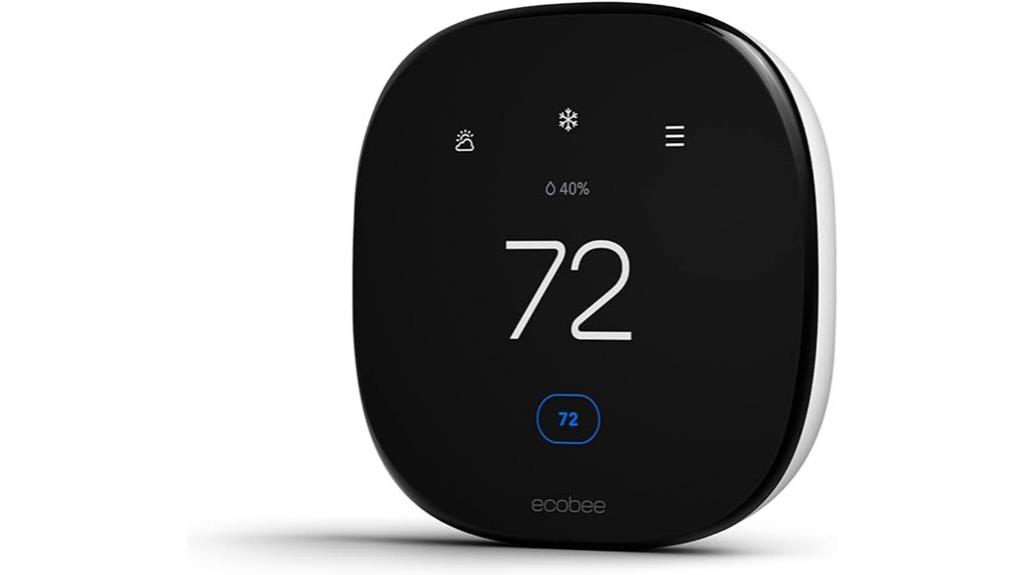
If you’re looking to maximize energy savings while maintaining comfort, the ecobee Smart Thermostat Enhanced is an excellent choice. It can save up to 26% annually on heating and cooling costs by automatically adjusting temperatures when you’re away, preventing waste. It preheats or pre-cools your home before you arrive for instant comfort and adjusts based on humidity to keep levels consistent. With SmartSensor technology, it monitors room-specific temperatures, focusing on key areas. Compatible with popular smart home platforms and controllable via the Ecobee app or voice commands, it’s easy to install and works with most HVAC systems, making it a reliable, energy-efficient upgrade.
Best For: homeowners seeking a smart, energy-efficient thermostat that can easily integrate with existing smart home systems and optimize comfort and savings.
Pros:
- Saves up to 26% annually on heating and cooling costs through automatic adjustments.
- Compatible with major smart home platforms like Alexa, Google Assistant, and Siri for convenient control.
- Easy to install with a Power Extender Kit and compatible with 90% of HVAC systems, including various heat pump configurations.
Cons:
- May require professional installation for optimal setup, especially when using the Power Extender Kit.
- Some advanced features, like SmartSensor, may incur additional costs.
- Compatibility may vary with older or less common HVAC systems, potentially limiting functionality.
Honeywell Home T9 WiFi Smart Thermostat

The Honeywell Home T9 WiFi Smart Thermostat stands out for homeowners seeking flexible, multi-room climate control with energy-saving features. It offers a sleek touchscreen display, supports voice control via Alexa, Google Assistant, Apple HomeKit, and SmartThings, and works with various HVAC systems, including forced air, hot water, steam, and heat pumps. With its smart room sensors, you can monitor and adjust temperature in different rooms, optimizing comfort. The device is easy to install with a C-wire or included adapter, and the app simplifies setup and management. Despite some Wi-Fi connectivity challenges, especially with 5GHz networks, the T9 provides reliable, customizable control for smarter home comfort.
Best For: homeowners seeking flexible, multi-room climate control with energy-saving features and compatibility with various HVAC systems.
Pros:
- Supports multiple control methods including voice assistants and app management for convenience.
- Works with Honeywell Smart Room Sensors to optimize comfort across different rooms.
- Easy DIY installation with guidance and included power adapter for homes without a C-wire.
Cons:
- Higher price point over $300 with sensors included.
- Occasional Wi-Fi connectivity issues, particularly with 5GHz networks.
- Limited instructions for sensor placement and setup, which may require additional securing methods.
Sensi Smart Thermostat
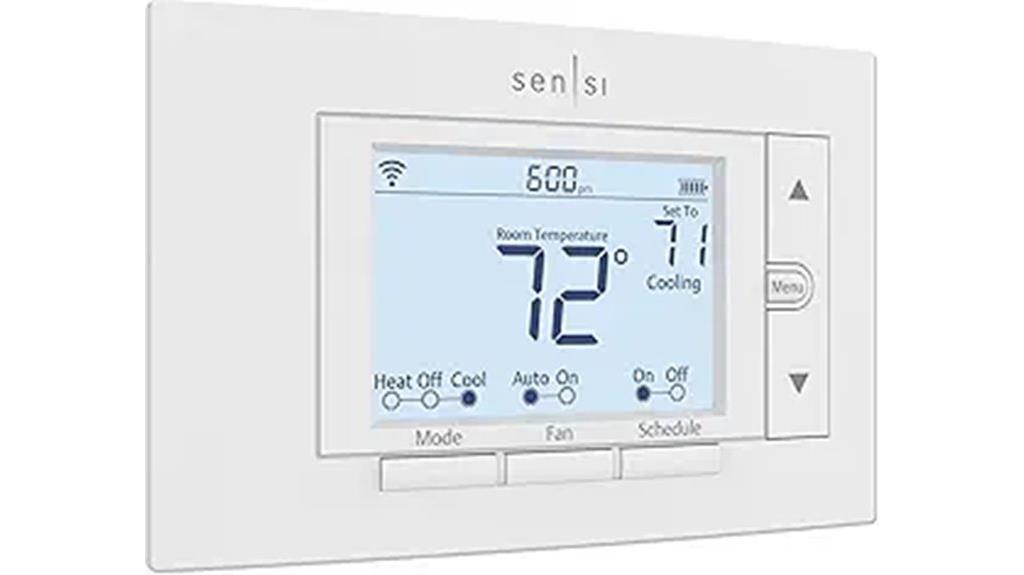
For homeowners seeking an easy-to-install smart thermostat that seamlessly integrates with their HVAC system, the Sensi Smart Thermostat (model ST55) stands out. It offers Wi-Fi connectivity, programmable scheduling, and voice control compatibility with Alexa, Google Assistant, SmartThings, and Vera. Its sleek LED display and button controls fit the same space as traditional thermostats, making DIY installation simple—often without a C-wire. Features like filter alerts, humidity management, and auto changeover enhance comfort and efficiency. Certified by Energy Star, it helps save around 23% on energy bills. With reliable app guidance and strong connectivity, Sensi provides a user-friendly experience for those seeking smart home comfort.
Best For: homeowners seeking an easy-to-install, reliable smart thermostat with energy savings and voice control compatibility.
Pros:
- Easy DIY installation, often without needing a C-wire
- Compatible with Alexa, Google Assistant, SmartThings, and Vera for voice control
- Energy Star certified, offering around 23% savings on HVAC energy bills
Cons:
- Limited detailed usage data and customization options
- No support for Bixby voice assistant
- Occasional connectivity or setting adjustment issues reported by some users
Amazon Smart Thermostat
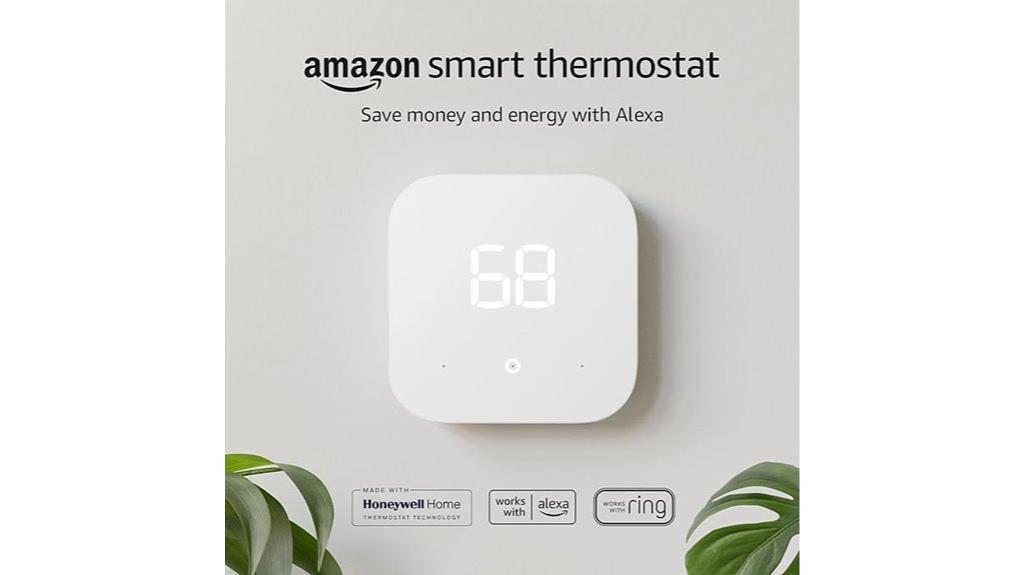
Designed for homeowners seeking an easy upgrade to a smarter, more efficient home, the Amazon Smart Thermostat features seamless integration with Alexa and Ring devices. It supports C-wire installation for straightforward setup and can be controlled via voice or the Alexa app from anywhere. Compatible with Echo devices like the Echo Dot (4th and 5th gen) and Amazon Smart Air Quality Monitor, it allows for temperature sensing and zone management. Built with trusted Honeywell technology, it’s reliable and durable. Plus, it helps save energy and costs, with EPA estimates showing about $50 annual savings, and guides to access local rebates for even greater savings.
Best For: homeowners seeking an easy-to-install, reliable smart thermostat that integrates seamlessly with Alexa and Ring devices for energy savings and convenient remote control.
Pros:
- Supports C-wire installation for straightforward setup and compatibility
- Integrates seamlessly with Alexa and Ring devices for voice control and automation
- Helps reduce energy costs, with EPA estimates of around $50 annual savings
Cons:
- Limited compatibility with non-Alexa or Ring smart home ecosystems
- Requires a C-wire in your existing thermostat for optimal installation
- May need assistance from customer support for initial setup or troubleshooting
Smart WiFi Thermostat with Room Sensor and Touchscreen
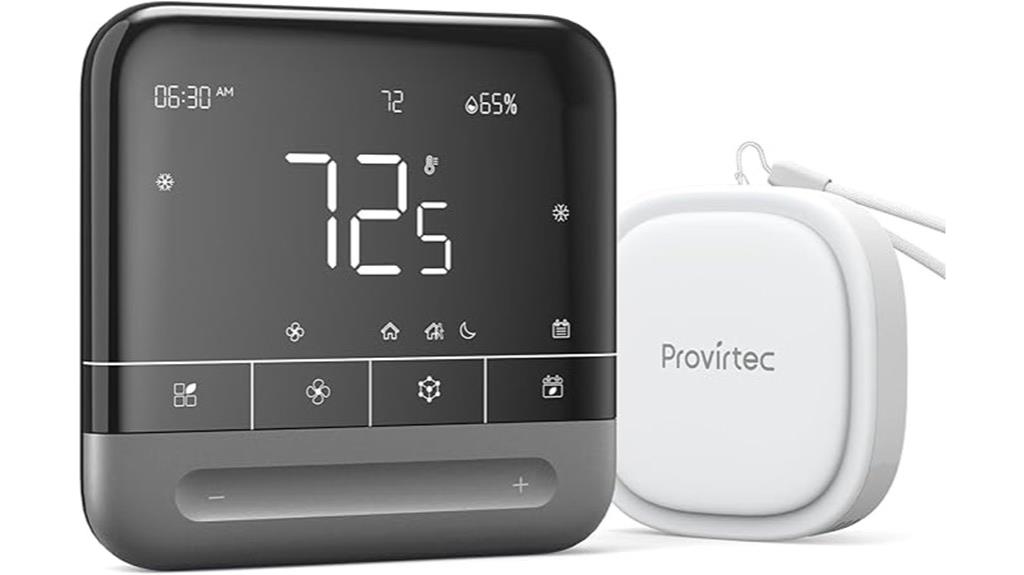
If you want a smart thermostat that combines intuitive control with precise temperature management, the Smart WiFi Thermostat with Room Sensor and Touchscreen is an excellent choice. It supports over 95% of 24VAC HVAC systems, including central air, heat pumps, boilers, and furnaces, but requires a C wire. Its 7-day programmable schedule and Sleep/Home/Away modes help optimize comfort and energy savings, up to 26% annually. The large 3.95-inch touchscreen and user-friendly sliding controls make adjustments easy for everyone. Plus, real-time home environment monitoring via Provirtec sensors and app control ensure you stay connected and in control, wherever you are.
Best For: homeowners seeking an easy-to-use, energy-efficient smart thermostat compatible with most 24VAC HVAC systems, including those who value remote control and precise temperature management.
Pros:
- Supports over 95% of 24VAC HVAC systems, including central air, heat pumps, boilers, and furnaces.
- Features a large 3.95-inch touchscreen and user-friendly sliding controls suitable for all ages.
- Offers energy savings of up to 26% annually with customizable schedules and smart modes.
Cons:
- Requires a C wire for installation; not compatible with high-voltage or millivolt systems.
- Does not support S terminals for indoor/outdoor sensors.
- Firmware updates and thermo-hygrometer pairing require WiFi connection, which may be an issue during network outages.
Sensi Lite Smart Thermostat
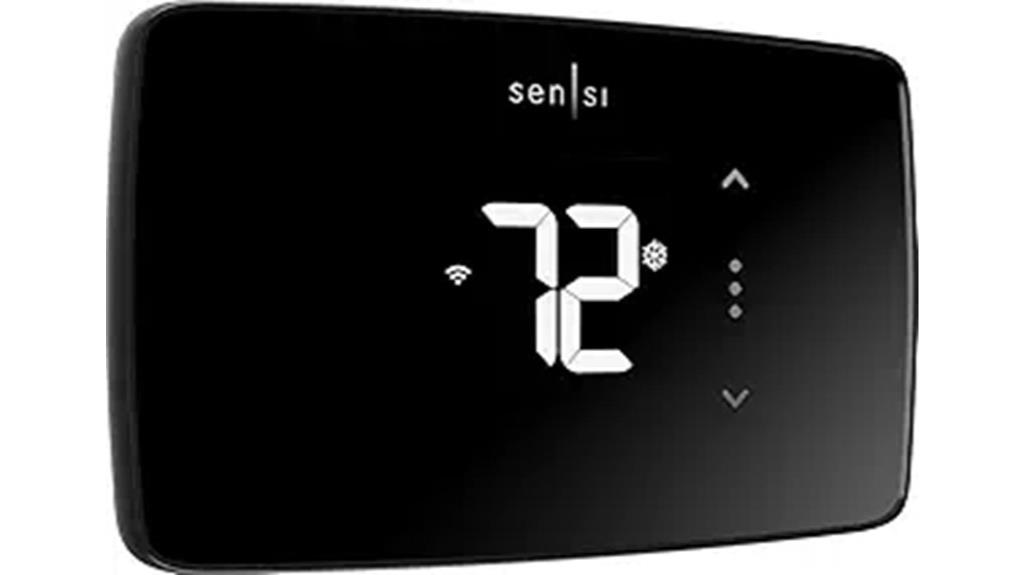
The Sensi Lite Smart Thermostat stands out as an excellent choice for homeowners seeking an easy-to-install, energy-efficient device that offers remote control and scheduling. Made by Emerson, it’s Energy Star certified and compatible with various HVAC systems, including boilers, heat pumps, and air conditioners. Its simple LCD display, backlight, and straightforward design make setup a breeze, especially with step-by-step guides and a QR code. With Wi-Fi connectivity, app control, and voice assistant support, it provides flexible temperature management. Despite some connectivity quirks, most users appreciate its ease of use, energy savings, and compatibility, making it a solid choice for smarter home comfort.
Best For: homeowners seeking an easy-to-install, energy-efficient smart thermostat compatible with a variety of HVAC systems and looking for remote control and scheduling features.
Pros:
- User-friendly installation with step-by-step guides and QR code setup
- Compatible with multiple HVAC systems including boilers, heat pumps, and air conditioners
- Energy Star certified, providing approximately 23% HVAC energy savings
Cons:
- Occasional Wi-Fi connectivity issues requiring troubleshooting after power outages or battery changes
- Limited scheduling flexibility and less detailed usage statistics in the app
- Not recommended for use outside US/Canada and may require additional wiring for certain systems
Emerson 1F85U-22PR Programmable Thermostat
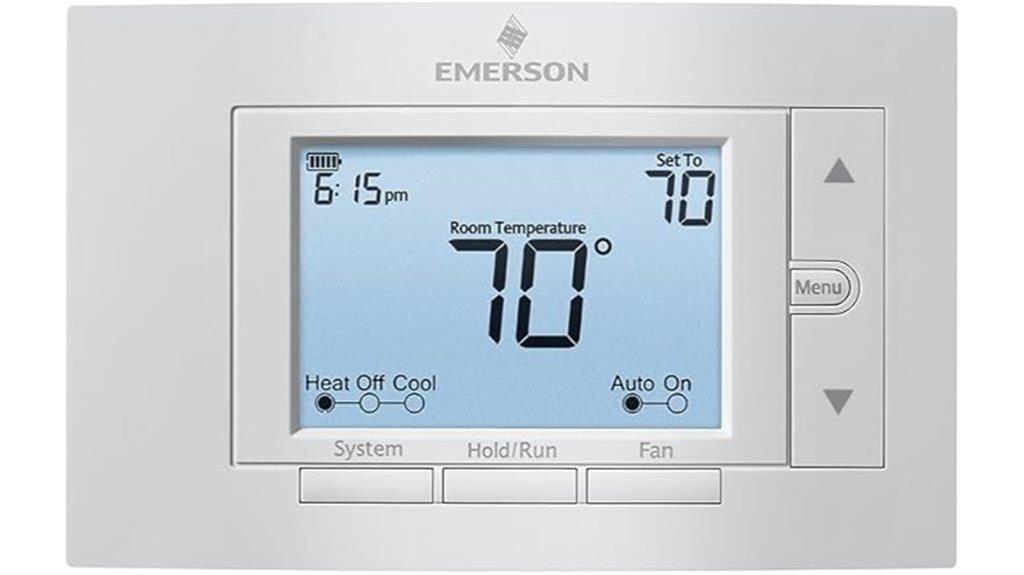
The Emerson 1F85U-22PR Programmable Thermostat stands out for its large, easy-to-read LCD display, making it ideal for users who prioritize clear visibility and straightforward operation. I appreciate its flexible programming options, including 7-day, 5-1-1, or off schedules, with separate settings for heating and cooling. The device supports dual fuel systems and two-stage HVAC setups, including heat pumps, without extra sensors. Its Wi-Fi connectivity allows remote control, but it performs well offline too. With features like keypad lock, temperature limits, and filter indicators, I find it reliable and user-friendly, especially for those seeking a versatile, easy-to-install thermostat.
Best For: homeowners seeking an easy-to-read, versatile programmable thermostat with reliable performance and flexible scheduling options.
Pros:
- Large, clear LCD display for easy reading in any lighting condition
- Supports multiple scheduling options including 7-day and 5-1-1 plans
- Compatible with various HVAC systems, including heat pumps and dual fuel setups
Cons:
- Display clarity may diminish over time for some users
- Requires two AA batteries for backup; batteries need replacement periodically
- No built-in sensors needed, but limited advanced sensor options for zone control
Inkbird ITC-308 Digital Temperature Controller (110V, 10A)
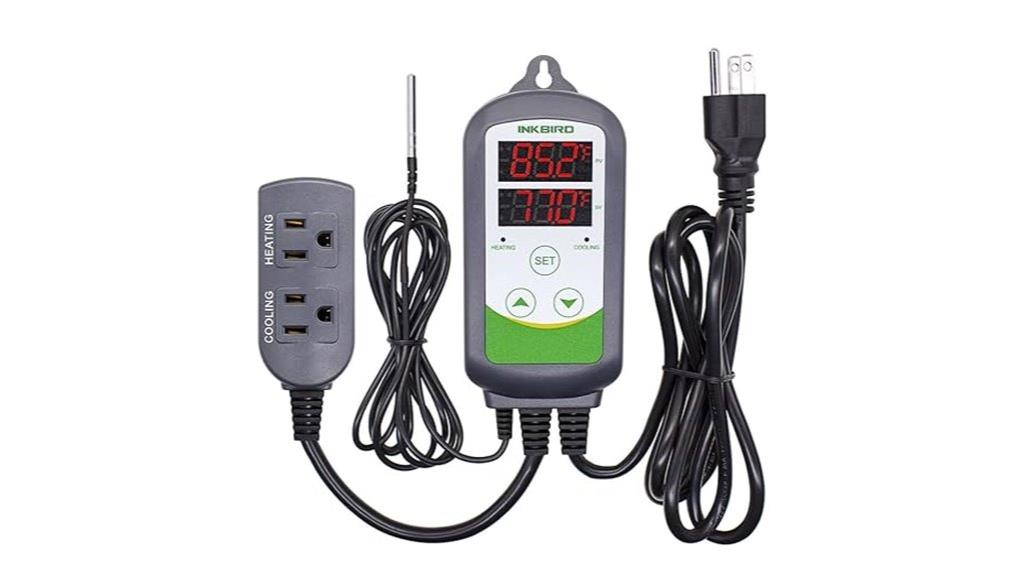
For anyone seeking precise temperature control in applications like homebrewing or greenhouses, the Inkbird ITC-308 Digital Temperature Controller stands out with its dual relay outputs and easy plug-and-play setup. It supports both Celsius and Fahrenheit readings, making it versatile. The dual display shows current and set temperatures clearly, allowing quick adjustments. With high and low-temperature alarms and buzzer alerts, you’re notified instantly when thresholds are reached. Its 110V, 10A capacity handles various appliances, and features like temperature calibration and compressor delay protect your equipment. Overall, it’s a straightforward, reliable choice for maintaining ideal environments.
Best For: homebrewers, gardeners, and hobbyists seeking reliable, precise temperature control for fermenters, greenhouses, and terrariums.
Pros:
- Easy plug-and-play setup with dual relay outputs for heating and cooling devices
- Supports Celsius and Fahrenheit for versatile temperature readings
- High and low-temperature alarms with buzzer alerts for real-time notifications
Cons:
- Max output load of 1100 W may limit use with high-power appliances
- Requires 110V power supply, incompatible with 220V systems in some regions
- Limited advanced features; primarily designed for straightforward temperature control
Sensi Lite Smart Thermostat
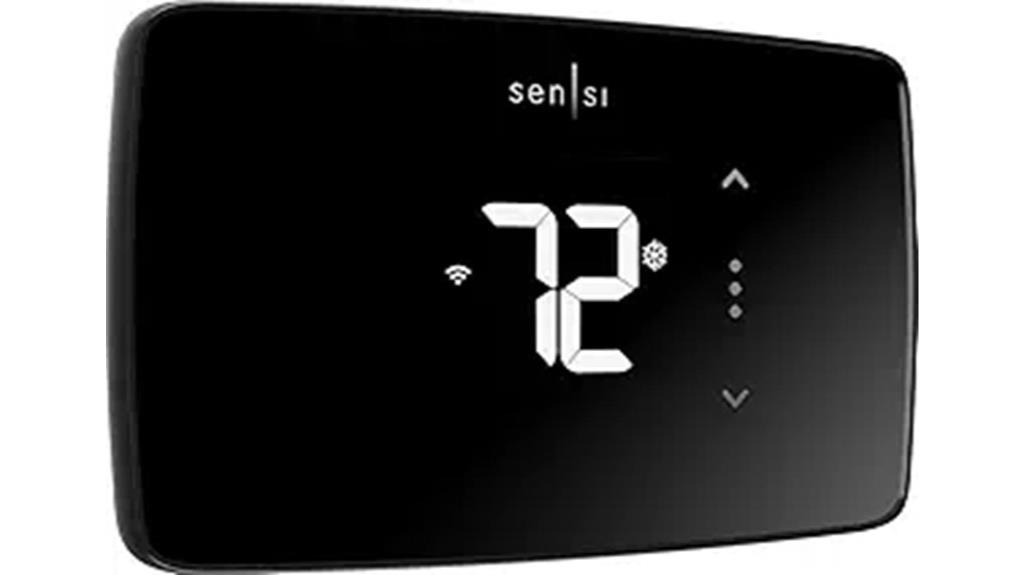
Are you seeking an easy-to-install smart thermostat that offers reliable Wi-Fi control and energy savings? The Sensi Lite Smart Thermostat by Emerson fits the bill perfectly. It’s compact, simple to set up with step-by-step guides, and compatible with most HVAC systems—no C-wire needed for most setups. It supports app control, works with Alexa and Google Assistant, and features programmable schedules, auto changeover, and a filter indicator. Certified by Energy Star, it can save around 23% on HVAC energy costs. Its sleek design and straightforward operation make it an excellent choice for those wanting smarter home comfort without complicated installation or excessive features.
Best For: homeowners seeking an easy-to-install, energy-saving smart thermostat compatible with most HVAC systems and voice assistants.
Pros:
- Simple DIY installation with clear guides and minimal wiring requirements
- Compatible with Alexa, Google Assistant, and SmartThings for remote control
- Supports programmable schedules and energy-saving features, certified by Energy Star
Cons:
- Wi-Fi connectivity issues reported after power outages or battery replacements
- Limited scheduling flexibility and app feature set compared to higher-end models
- Not recommended for complex HVAC systems outside US/Canada or those needing C-wire for heat pump systems
Factors to Consider When Choosing a Smart Thermostat With Climate Prediction
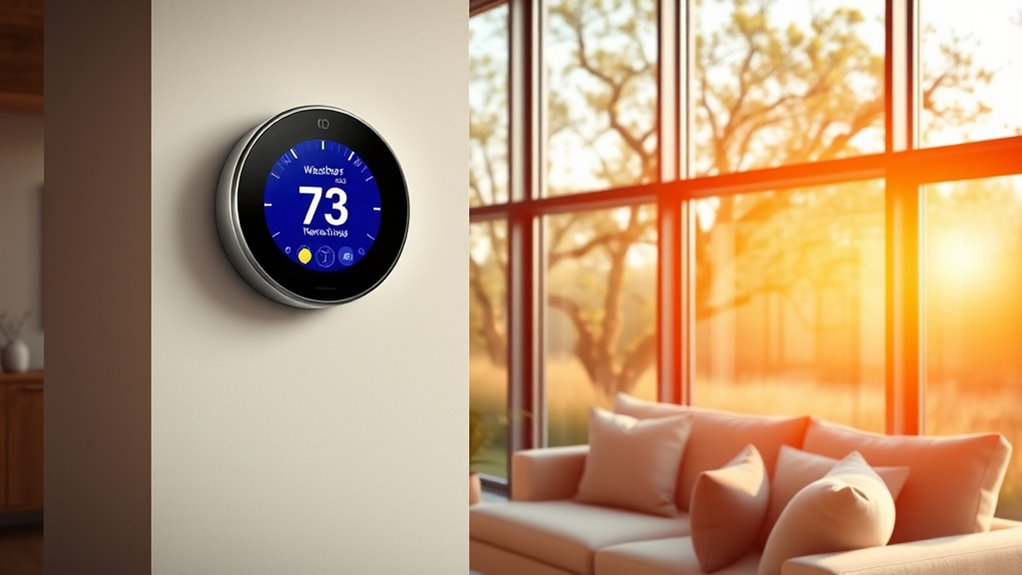
When choosing a smart thermostat with climate prediction, I look at how accurately it forecasts weather patterns and how well it integrates with my HVAC system. I also consider whether the interface is easy to use and if it works seamlessly with my other smart devices. Finally, I evaluate its energy-saving features to guarantee I get the most efficiency and savings.
Climate Prediction Accuracy
Have you ever wondered how accurately a smart thermostat can predict your climate needs? The answer depends on several factors. High-quality sensors and frequent data collection are essential for precise forecasts. Advanced models leverage machine learning algorithms to analyze trends and adapt to seasonal changes, enhancing long-term accuracy. The integration of external weather services can improve predictions but varies in reliability, affecting overall precision. Real-time data updates and multiple sensor inputs help the thermostat respond quickly to environmental changes. Ultimately, better prediction accuracy means more efficient pre-heating or cooling, leading to energy savings and consistent comfort. When choosing a thermostat, consider how well its algorithms and data sources work together to deliver reliable climate forecasts tailored to your home.
Compatibility With HVAC Systems
Choosing a smart thermostat with climate prediction capabilities means making certain it works seamlessly with your existing HVAC system. First, check if it’s compatible with your system type—forced air, heat pump, boiler, or electric—so it functions correctly. Determine whether it needs a C-wire for power or supports power-sharing options, especially if your setup lacks a dedicated common wire. If your system has multiple stages for heating or cooling, ensure the thermostat supports multi-stage operation for ideal comfort. Also, verify compatibility with your HVAC control protocols, like 24V AC systems, to avoid installation issues. Finally, consider if it supports advanced features like zone control or dual fuel setups, which can enhance climate prediction and overall system performance.
User-Friendly Interface
A user-friendly interface is essential for getting the most out of your smart thermostat with climate prediction. It should feature intuitive controls, clear displays, and easy navigation to make daily adjustments simple. Large, high-contrast screens with adjustable brightness improve visibility for users of all ages, especially in low-light settings. Responsive touchscreens with quick feedback allow for seamless setting changes without accidental inputs, enhancing usability. Simplified menus and setup wizards help you configure schedules and preferences effortlessly, even if you’re not tech-savvy. Visual cues like icons and color-coded options make it easier to understand system status at a glance, so you can recognize active modes or alerts quickly. Overall, a well-designed interface guarantees smooth operation and maximizes your thermostat’s climate prediction capabilities.
Integration With Smart Devices
Integrating your smart thermostat with other devices can substantially enhance comfort and efficiency. With voice control through platforms like Alexa, Google Assistant, or Siri, managing your home’s climate becomes effortless. Compatibility with various smart home ecosystems ensures seamless automation, such as adjusting temperatures based on occupancy or weather data. Integration with smart sensors and climate prediction features allows the thermostat to preemptively optimize settings, saving energy while maintaining comfort. Support for Matter technology further simplifies integration across multiple protocols and devices, reducing setup complexity. Additionally, a well-integrated thermostat can send notifications or alerts about weather changes or system issues directly to your phone or smart home hub, enabling proactive management. Choosing a thermostat with robust device integration means a smarter, more responsive, and more convenient home environment.
Energy Saving Features
When selecting a smart thermostat with climate prediction, it’s crucial to take into account its energy-saving features, as these can greatly decrease your heating and cooling expenses. These thermostats optimize energy use by adjusting temperatures proactively based on weather forecasts, potentially saving up to 26% annually. Features like adaptive scheduling and automatic temperature adjustments help reduce unnecessary HVAC operation, lowering your energy bills. Integration with humidity sensors and weather data ensures your home remains comfortable during seasonal changes while minimizing waste. Some models even preheat or precool your home before you arrive, based on weather predictions. Additionally, alerts and notifications inform you of savings opportunities and system performance, encouraging more conscious energy consumption and making your home both smarter and more efficient.
Frequently Asked Questions
How Do Smart Thermostats Adapt to Changing Weather Patterns Automatically?
You’re wondering how smart thermostats adapt to changing weather patterns automatically. I find that they use built-in sensors and weather data integration to monitor outdoor conditions constantly. When the forecast predicts a temperature shift, the thermostat adjusts your home’s heating or cooling accordingly. This way, your system responds proactively, maintaining comfort while saving energy. It’s like having a smart assistant that keeps your home perfectly cozy without you having to lift a finger.
Can Climate Prediction Features Reduce Overall Energy Consumption Effectively?
Climate prediction features can definitely help reduce overall energy consumption. By anticipating upcoming weather changes, my smart thermostat adjusts heating or cooling proactively, avoiding unnecessary energy use. This means I stay comfortable without overworking my HVAC system. Over time, I notice lower energy bills and less environmental impact. It’s like having a weather-savvy assistant that keeps my home cozy efficiently, saving me money and energy.
Are There Compatibility Issues With Existing HVAC Systems for Climate Prediction Models?
Thinking about compatibility issues, I’ve found that climate prediction models can sometimes face challenges with existing HVAC systems. It’s like fitting a puzzle piece; some systems integrate seamlessly, while others need adapters or upgrades. I recommend checking your HVAC’s congruence before choosing a smart thermostat with climate prediction features. That way, you avoid surprises and ensure your home stays comfortable and energy-efficient without a hitch.
How Secure Is the Data Collected by Smart Thermostats With Climate Prediction?
You’re wondering about the security of data collected by smart thermostats with climate prediction. I believe these devices take privacy seriously, using encryption and secure connections to safeguard your information. However, as with any smart device, there’s always some risk. I recommend keeping firmware updated, changing default passwords, and reviewing privacy settings regularly to ensure your data stays safe and confidential.
Do Climate Prediction Features Require Ongoing Subscriptions or Additional Costs?
Many smart thermostats with climate prediction features often come with a gentle nudge toward optional subscriptions, but it’s not always a must-have. Sometimes, these features are included in the device’s core package, saving you extra costs. I’ve found that a few brands offer free updates, while others have premium plans for additional insights. So, it’s worth checking each model’s details to see what fits your budget and needs best.
Conclusion
Choosing the right smart thermostat is like finding the perfect compass for your home’s comfort journey. With features like climate prediction, you’re not just adjusting the temperature—you’re guiding your space to ideal coziness effortlessly. Whether you prefer the sleek intelligence of Google Nest or the advanced sensors of ecobee, there’s a perfect match for your lifestyle. Embrace these smart tools to make your home’s climate as harmonious as a well-conducted symphony.
